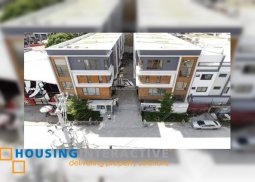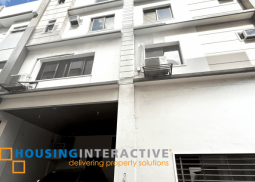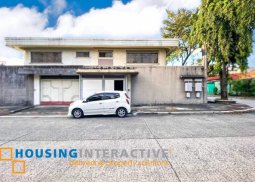Philippines' 1st Property Portal
house for sale in Sta. Mesa, Manila
5 properties found Updated Jun 25, 2024
Updated Jun 25, 2024
- 3
- Sta. Mesa, Manila
 Updated Mar 27, 2024
Updated Mar 27, 2024
- 4
- 2
- 6
- Sta. Mesa, Manila
 Updated Mar 25, 2024
Updated Mar 25, 2024
- 4
- 3
- 3
- Sta. Mesa, Manila
 Updated Sep 29, 2022
Updated Sep 29, 2022
- 5
- 3
- 5
- Sta. Mesa, Manila
 Updated Jul 25, 2023
Updated Jul 25, 2023
- 6
- 3
- 6
- Sta. Mesa, Manila
Houses for Sale in Sta. Mesa, Manila
Sta. Mesa: A Hidden Gem in the City of Manila
Sta. Mesa or the Sta. Mesa District of the City of Manila is situated in the easternmost part of the city. It is beside the cities of Quezon City, San Juan, and Mandaluyong. Sta. Mesa has a rich cultural significance in Manila due to its location near Pasig River which connects the district to the rest of the Metro. The revitalized Manila Bay, Pasig River, and Laguna de Bay Ferry System can also help decongest the main thoroughfares traversing all around Metro Manila—the houses for sale in Sta. Mesa is a great investment due to its proximity to quality education, work, and attractions that are just a few minutes away from home. The district’s vibrant and attractive scene makes homebuyers and property investors think about the potential of owning a property in Manila.
Places to visit near Sta. Mesa
The residential properties for sale in Sta. Tourist attractions and high-end malls surround Mesa without traveling far from home. Here are some of the destinations you can visit with your family and friends:
Minor Basilica of San Sebastian
The Minor Basilica of San Sebastian, also known as San Sebastian Basilica, is a historic landmark and a testament to architectural ingenuity. It is the only all-metal church in East Asia, and its construction began in 1621. The basilica's neo-gothic design and steel structure make it a unique attraction in the Philippines. Visitors are often awed by its stained glass windows, intricate details, and the serene ambiance that offers a respite from the bustling city life.
Museo ng Malacañang
Museo ng Malacañang or Malacañang Museum is located inside the grounds of Malacañang Palace. The Malacañang Palace has been the official residence of the President of the Philippines since 1935. It was the home of a certain Spanish aristocrat to American Governor Generals who oversaw the affairs when it was still under American rule. After the Philippines had a president that they could recognize – Manuel Quezon, it never changed since. In Malacañang Museum guests can see several artworks, memorabilia, artifacts, and many more that will shine over the rich historical and cultural past of the Philippines. There is a list of the Philippine Presidents who served the country as well as their accomplishments. Visiting this museum will not cost you a penny, as indicated by the President. But guests are obliged to make a booking 3-5 business days before the actual tour and provide requirements such as identifications and passports for ease of processing.
Intramuros
Intramuros or the Walled City of Intramuros was established by the Spaniards specifically by Miguel Lopez De Legazpi as a Seat of Power in the Philippine Islands on the 24th of June 1571. The Old Manila has been the center for chief affairs in terms of politics and religion. The 2 most important structures in the area are the Palacio del Gobernador, where the Governor General resides, and the Manila Cathedral, the head of the Catholic Church in the Philippines until now. Fort Santiago is one of the vital parts of Intramuros known as headquarters and a prison for their captives. Before the reclamation during the American Period. The eastern side of the Walled City is still facing Manila Bay. Its walls also act as a defense against invaders coming from the sea. Manila is full of historical landmarks that are worth a visit and it can be accessed both by car and public transportation. Mesmerize about the cultural past of Manila through Intramuros.
Sta. Mesa will never cease to amaze its residents with rich landmarks and establishments. Homeowners have the convenience to visit museums, parks, malls, and restaurants that are a stone’s throw away from their place of residence. They also learn from history thanks to the long-standing structures that still hold their own stories to tell like locals and tourists alike.
Why live in Sta. Mesa?
Sta. Mesa is located in a strategic spot in the city close to major thoroughfares, public transportation, world-class education, and companies. If you are planning to survey the area, the following are the reasons to invest in a property in the district:
Strategic location
The houses for sale in Sta. Mesa is close to key landmarks and establishments. Accessibility is one of its greatest suits close to roads and public transportation as well as schools, companies, and leisure destinations. Owning a residential property in this part of Manila is a great asset and you will never run out of things to do.
Quality education is just nearby
The perks of acquiring a house in the area are its proximity to competitive schools and colleges. Some of the noteworthy educational institutions close to home are as follows: Christian Academy School, St. Jude Catholic School, Arellano University, and San Beda University. The proximity to these institutions ensures that students have shorter travel times, allowing them to focus more on their studies and extracurricular activities. Moreover, living close to educational institutions can enhance property values, making it a wise investment.
Close to career opportunities and business districts
Sta. Mesa is surrounded by several commercial and business hubs, providing residents with ample job opportunities and access to essential services. The area is near major business districts like Makati, Ortigas, and Manila, where numerous multinational companies and local businesses are located. This proximity makes Sta. Mesa is an attractive location for professionals who want to live close to their workplaces. Additionally, the presence of shopping malls, restaurants, and entertainment centers in and around Sta. Mesa ensures that residents have easy access to shopping, dining, and leisure activities.
Community and Lifestyle
The district has a vibrant lifestyle as one community. Various community events, local markets, and recreational activities provide opportunities for socialization and community engagement. The presence of parks and open spaces also offers residents places to relax and enjoy outdoor activities, contributing to a balanced and fulfilling lifestyle.
Investment Potential
The public infrastructure is currently changing in Metro Manila. The Light Rail Transit is linked through a footbridge connecting Recto Station and the 9th Station of LRT-1 – Doroteo Jose. LRT-1 is pushing with its development that will expand through Parañaque, the Ninoy Aquino International Airport (NAIA), and the Province of Cavite. This LRT Line is connected to the Union Grand Central Station or the North Rail Common Station which also houses the following rail networks such as MRT-3, MRT-7, and the Metro Manila Subway. This kind of interconnectivity alongside public transportation networks is a one-step forward for commuters and pedestrians to travel anywhere in Metro Manila with ease.
As the real estate landscape in Sta. Mesa, Manila continues to evolve, and the prospect of finding houses for sale in this vibrant area presents an enticing opportunity for potential homeowners and investors alike. Sta. Mesa, known for its strategic location and rich cultural tapestry, offers a diverse array of houses for sale in Sta. Mesa caters to various preferences and budgets. From quaint, family-oriented residences nestled in serene neighborhoods to more modern, high-rise condominiums boasting panoramic city views, the options are as varied as the community itself. The area's connectivity, with its proximity to major thoroughfares, public transportation hubs, and essential amenities, enhances its appeal. Schools, shopping centers, and recreational facilities are easily accessible, making Sta. Mesa is an attractive choice for families, young professionals, and retirees.
How much is a house for sale in Sta. Mesa, Manila?
In total, there are 5 house for sale in Sta. Mesa, Manila. The average price for a residential property for sale in this location is ₱0 per unit. The most expensive sales price for a residential property here costs about ₱0 while the most affordable sales price is about ₱0.
You may find the most expensive and luxurious house for sale in Sta. Mesa, Manila. While you can find classy yet affordable ones also at the same location.
Below are the average sales prices according to the number of bedrooms in this location.
| Bedrooms | Average Floor Area/SQM | Average Sales Price | Average Cost Price/SQM |
|---|---|---|---|
| 4 Bedrooms | 418sqm | ₱0 | ₱0sqm |
| 3 Bedrooms | 254sqm | ₱0 | ₱0sqm |
These properties are fully equipped with the following amenities and unit features:
- Air conditioning
- Balcony
- Built-in wardrobes
- Drying Area
- Fire Exits
- Flex
- Garden
- Laundry Area
- Parking Space
- Pet Friendly
- Shower rooms